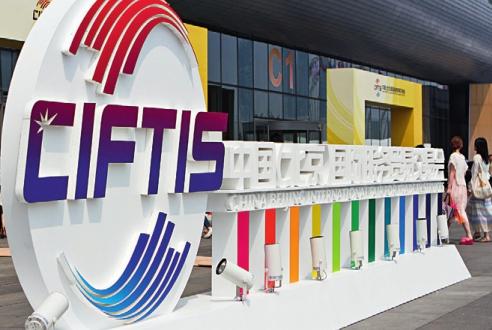Tapping into China’s Service Economy
By LIU LIN & ZHANG ZHIMEI
THE Fourth China (Beijing) In- ternational Fair for Trade in Services (CIFTIS) convened at the National Convention Center in Beijing from May 28 to June 1, 2016. A large-scale international fair for trade in services, it features a 50,000 squaremeter exhibition space with 122 professional forums. The fair welcomed nearly 2,000 exhibitors from 100-odd countries and regions around the world who came on a quest for business opportunities. The fair encompassed all 12 sectors of the service trade as classified by the World Trade Organization: Business and professional services, Communication services, Construction and related services, Distribution services, Educational services, Energy services, Environmental services, Financial services, Health and social services, Tourism services, Transport services and Movement of natural persons.
A Grand Fair for Trade in Services
With its proportion of global GDP nudging 70 percent – a proportion nearing 80 percent even in major developed economies – the service industry is a primary prop of todays world economy. Increasingly the new dynamo for economic growth, the service industry and trade stand in the limelight of international economic cooperation today.
Established in 2012, CIFTIS is not simply a trade show. Commerce Minister Gao Hucheng remarked that the CIFTIS serves as a new engine for Chinas economic transformation, a “weathervane”of global trade in services, and a new arena for international exchanges and cooperation. “The vitality of CIFTIS inheres in its function of facilitating deals by setting up a corresponding platform. Both before and during the fair, much effort has gone into inviting professional buyers, and matching sellers with these buyers,” said Qiu Lixin, director of the Department of Trade in Services and Commercial Services of the Ministry of Commerce.
The previous three CIFTIS have helped arouse active transactional demand and tapped into a huge potential market, and thus attained a resounding success. Wen Jiabao, Chinas then premier and Li Keqiang, Chinas incumbent premier, attended the first and second CIFTIS respectively, and addressed their summits. Wang Yang, Chinas vice premier, presented a written address to the third CIFTIS, expressing his confidence and resolve that China will further expand and open its service industry. He has also twice personally visited the CIFTIS venue to inform himself of new developments in the trade in services. The previous three CIFTIS attracted 50-odd international organizations and industry associations, as well as some 6,100 enterprises from 154 countries and regions to partake of its 411 traderelated activities, realizing an intended turnover of more than US $220 billion, with international deals scooping up over 30 percent of total volume.
Whats New about This Years Event
According to Yan Ligang, director of the Beijing Municipal Commission of Commerce – incidentally in charge of this years CIFTIS – many innovations greeted this years event. An international cooperation department is in place to attract more superior resources in the service trade sector. Countries that are developed in the service trade and domestic cities that enjoy advantages therein were the subject of especial promotion during the event, which also focused on national macro-policy by setting up exhibition zones to showcase the results of Chinas cooperation with countries along the Belt and Road in infrastructure, industrial investment, trade and logistics, tourism, culture and other service trade sectors, as well as other innovations and the reform results of the Beijing-Tianjin-Hebei integration.
To alert the market to potential business opportunities for fair participants, two months before the fair a raft of new products were unveiled to the public. These span the six key service areas, namely science and technology, internet and information, culture and education, finance, business and tourism, and health and medical care. These products cover such sectors as virtual reality (VR), Internet plus e-commerce, cross-border remittances, and telemedicine.
Among the 32 participant countries and regions, including Singapore, South Korea, the Netherlands and the Czech Republic, 12 make the global top country list for service trade, and nine of these lie along the Belt and Road. Over 10 African countries banded into a group to participate in this years fair, while 31 provinces, municipalities and autonomous regions in Chinas mainland were present at this years event. With spectacular exhibitions and vanguard products, the fair has drawn a global clientele, among them professional buyers who discern a great market potential and thriving demand.
Added to the great number of representatives of various countries and regions attending, the fair is further noteworthy for enticing many companies and institutions of the ilk of Fortune Global 500 companies, multinationals, famous domestic enterprises and some unicorn companies in sectors such as e-commerce, sci-tech, finance, medical care, couriers, and sales and distribution. These will debut their latest products and share their exclusive analysis on data or policies as they attend the fair in a bid to secure cooperation.
New Era for Service Trade

In 2015, Chinas total service import and export volume hit US $713 billion, representing a 14.6 percent year-on-year growth, much higher than the average growth rate of the global trade in services, which stood at 4.7 percent. China thereby took second slot – next to the U.S. – among countries in terms of service trade.
In early 2015, the State Council published the Several Opinions on Accelerating the Development of the Service Trade, which underlined the need for efforts to erect platforms and organize various trade fairs to boost communication and cooperation in the service trade, with CIFTIS taking the lead.
The venue for CIFTIS is Beijing, which boasts the largest-scale service economy of all cities in Chinas mainland. Beijing is driving ahead to create service-driven economic growth, and its development of the service industry and trade ranks it foremost among Chinas mainland cities. Since 2015, when the State Council approved Beijing as the first pilot city for further opening-up of the service sector, the municipal government has taken a slew of new measures that have attained novel results and developments in such sectors as scitech, internet and information, culture and education, finance, business and tourism, and health and medical care. In February 2016, the State Council resolved to conduct service trade innovation development trials in 15 localities – among them Tianjin – with grant of policy support to realize the goal of furthering a transformation in foreign trade and bolstering the competitiveness of the local service industry.
That during the 13th Five-Year Plan period China must embrace a quality rather than a quantity-centered socio-economic development and shift its economic development from a manufacturing to a service-driven one is eminently foreseeable. Expanding two-way opening-up of the service industry and cultivating new advantages that heighten the competitiveness of the service industry is Chinas only path for consummating its transition from manufacturing to services.
The fourth CIFTIS not only heralds the coming of a new era for the service trade, but also concretely manifests Chinas resolve to develop its service economy.

